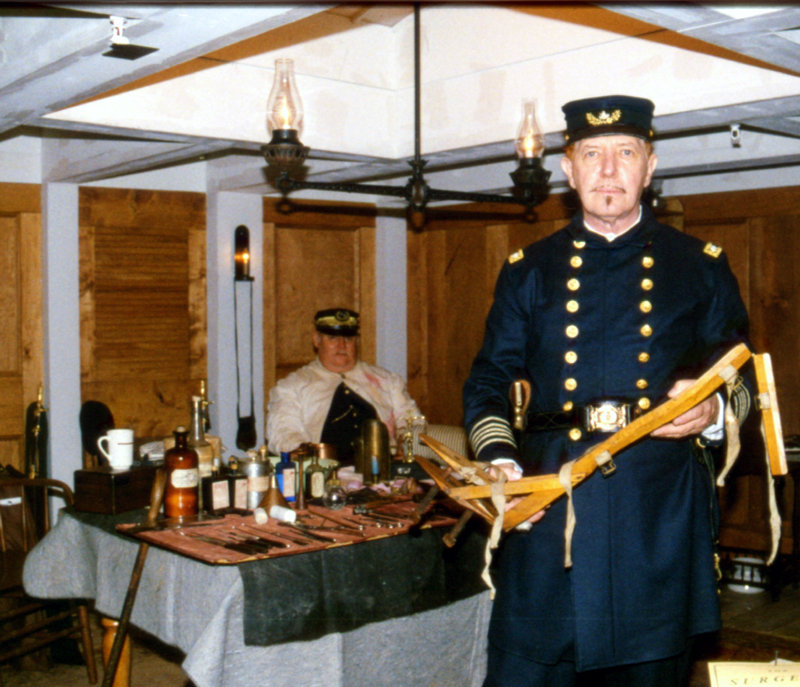|
War on the Waters
Article and photos by KathleenWalls
 |
| A Southern Belle inspects the CSS
Jackson |
Columbus, Georgia
is home to the only museum in the world dedicated to the naval history
of the War Between the States. The Port Columbus National Civil War
Naval Museum, which opened in the spring of 2001, brings both sides of
the conflict together and sheds light on a too-often-ignored aspect of
the war: battles that were fought in the water, not on the land.
The centerpiece of
the museum is a 180-foot piece of the original 225-foot hull of the CSS
Jackson. This massive ironclad was built at the Confederate
shipyards approximately 1 mile away from where it now rests. You can
view it from an observation platform near the bow, or from floor level.
The CSS Jackson
is the largest surviving Confederate ironclad. The ship was in the naval
yard and almost ready to be launched when a daring group of Union
soldiers crossed the Chattahoochee River on a dark night in April 1865
and burned it to the waterline. The hull floated 30 miles downriver,
where it lay covered with mud until its excavation in the early 1960s.
This section is but one-third of the original ship, yet it weighs in at
560,000 pounds. It originally contained six huge guns, iron plating, and
two 30,000-pound engines.
Another exhibit is
of the CSS Chattahoochee, a
gunboat built specifically to protect the the city of Columbus, Georgia
which was a big manufacturing center for military equipment and
uniforms.
Misfortune befell
the CSS Chattahoochee in 1863
when a boiler explosion killed 19 crewmen and sank the ship in the
Apalachicola River in North Florida. She was raised and returned to
Columbus in January of 1864 and underwent repairs. but was once again
sunk, this time by the Confederates in April, 1865 in an effort to keep
the ship from falling into Union hands.
 |
| CSS Albermarle at Civil War Naval
Museum |
She lay underwater
until the early 1960s when she was discovered and a portion of the
ship's hull and her original steam engines once more returned to her
home in Columbus. Due to her being submerged, the
CSS Chattahoochee was the
only Confederate Navy gunboat to survive the war.
The most expensive
exhibit at the Civil War Naval Museum is the reconstruction of the
ironclad CSS Albemarle. The Albemarle terrorized the Union fleet
until a young Union lieutenant made a daring raid in a small
steam-powered launch and sank it in the Roanoke River in Virginia. As
visitors stand in the hull of the ship, they experience what life was
like on board. They eavesdrop on a young "powder monkey" as he writes
home to his mother about life in an ironclad; encounter the enemy
cannonade; and feel the deck shudder beneath as the torpedoes strike
home. It's so realistic, you imagine you can feel the flow of the river
and the impact of the missiles.
 |
| Medical Exhibit at Civil War Naval
Museum |
One of the most realistic exhibits is the one relating to medical
practices onboard ships in that era. Land based hospitals were not much
better. Makes you realize that "calling in sick" then was not a good
option.
The museum harbors
its own bit of Confederate flag trivia. Thanks to a family from Ohio,
visitors can see a particular flag that was in hiding for 137 years. On
the night of July 22, 1862, the captain of the CSS Arkansas thought
they had reached safety in the harbor at Vicksburg, Mississippi, when,
out of the darkness, two Union ships struck. The USS Queen of the
West attempted to ram the Arkansas. As the two vessels lay side to
side, an enterprising civilian engineer aboard the Federal ship, John P.
Skelton, saw his chance for a souvenir. He leapt aboard the Arkansas and
tore down its flag. He managed to make it back to his own ship and hide
the flag in a barrel of beans. After his discharge, Skelton took the
purloined flag back to his family home in Ohio, where it remained until
1999 when his ancestors sent the emblem back home again. It now rests in
a place of honor on the wall of the museum.
 |
| Authentic Confederate flag at Naval
Museum |
The National Civil
War Naval Museum at Port Columbus's story of the war extends beyond the
actual walls of the building. Its newest exhibit the
USS Water Witch, a full-scale
model of this ship sits between the museum and Victory Drive.
The
USS Water Witch was a U.S.
side-wheel steamship which had already proven itself prior to the war.
It functioned as a supply ship, mail ship and was used in helping
maintain the Union blockading of
Savannah, GA. The ship was eventually taken in a surprise nighttime raid
by the Confederates . After its capture, the Confederates did not
utilize the
Water Witch and
eventually sank it to avoid its being recaptured by Union forces.
The
Water Witch today is still
serving citizens. She acts as a signpost pointing to a museum every
history buff should visit at least once.
For more info:
http://portcolumbus.org
----------
|
![]() Ads fund American Roads so please consider them for your needed
purchases.
Ads fund American Roads so please consider them for your needed
purchases.
If you enjoy the articles we offer, donations
are always welcome.
|